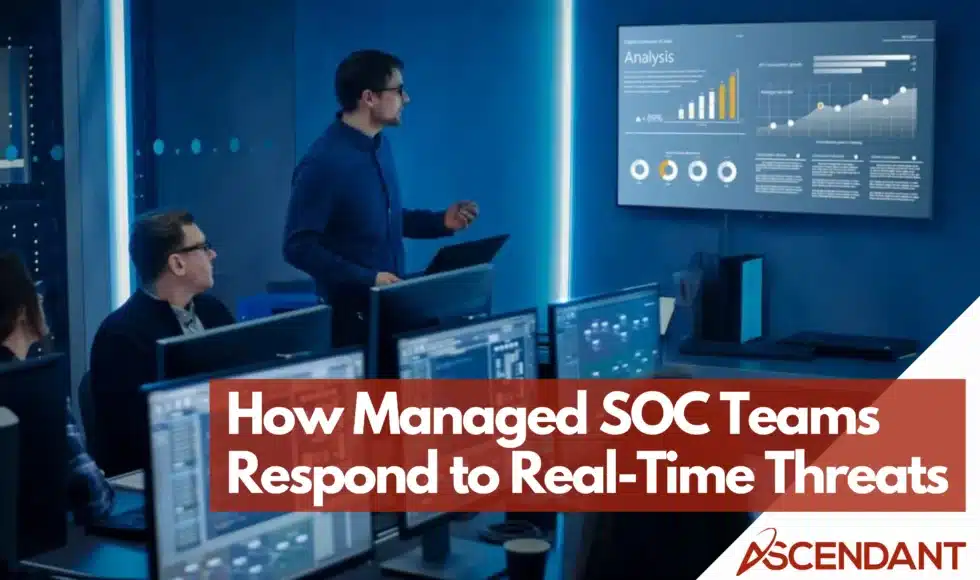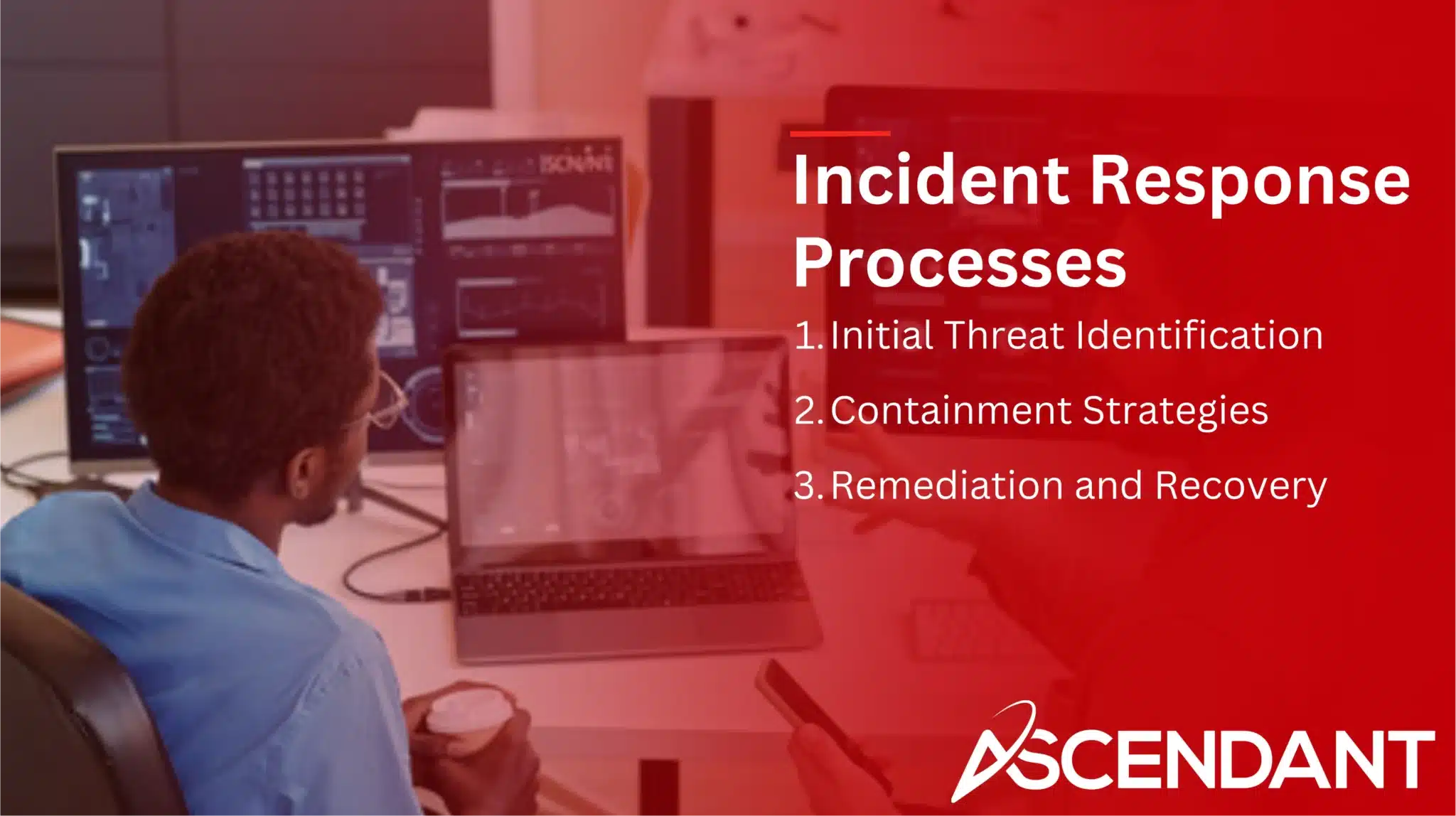Looking to understand how managed SOC teams respond to real time threats? Managed SOC teams use continuous monitoring, advanced security tools, and a coordinated response strategy to detect and mitigate cyber threats as they happen. This article will walk you through the key steps and best practices these teams follow to keep your digital assets secure.
In This Article:
- Overview of Managed SOC Teams
- Real-Time Threat Detection
- Incident Response Processes
- Role of Security Analysts in Real-Time Threat Management
- Tools and Technologies Used by Managed SOC Teams
- Proactive Threat Hunting
- Overcoming Challenges in Real-Time Threat Response
- Benefits of Managed SOC Services
- Best Practices for Effective Managed SOC Operations
Key Takeaways
- Managed SOC teams are essential for real-time monitoring, detection, and response to cyber threats, utilizing a structured approach involving analysts and advanced technologies.
- Real-time threat detection relies on continuous monitoring and the integration of AI-driven tools to promptly identify and address potential cyber threats.
- Incident response processes within SOCs emphasize swift threat identification, containment, and remediation, while proactive threat hunting practices help organizations uncover hidden malicious activities.
Overview of Managed SOC Teams
A Security Operations Center (SOC) is a dedicated facility staffed by expert teams responsible for real-time monitoring, threat detection, and incident response to safeguard an organization’s digital assets. These SOC teams are pivotal in offering continuous security monitoring and executing immediate actions against possible security threats. The presence of SOCs is critical for entities that prioritize data protection and robust cyber defense measures, including those with an in-house SOC.
Within these centers, various key personnel such as Security Analysts, Engineers, and Managers, who each play a crucial role in the overall function of the center. While SOC Managers are tasked with supervising operations, managing team members, and overseeing budgetary aspects. Security Analysts along with other SOC analysts and Threat Hunters take charge of persistently scrutinizing network behavior to spot potential risks promptly. This collaborative structure allows SOCs to adeptly navigate tasks ranging from assessing vulnerabilities to ensuring regulatory compliance—all highlighting how integral SOCs are within the realm of cybersecurity management.
To maintain superiority over threats within the complex evolving threat landscape requires SOPs rooted firmly in persistent surveillance, which paves way for instantaneous recognition followed by rapid reaction to any identified issues—operating tirelessly 24/7. By integrating state-of-the-art security tools into their regimen alongside advanced monitors specifically designed for recognizing nefarious activities or irregularities, they ensure even finer control throughout this process—a measure imperative amidst continually shifting tactics utilized by cyber adversaries targeting organizational assets.
Real-Time Threat Detection
The capacity for immediate detection of threats is essential in reducing the damage wrought by cyber attacks. To combat these dangers, SOC teams employ sophisticated technologies that scrutinize data and persistently oversee system actions to ensure early identification and resolution of any looming risks. The adoption of artificial intelligence (AI) and machine learning enhances their predictive capabilities, allowing them to identify patterns and foresee potential threats swiftly.
To achieve proficient threat detection in real time, it’s necessary to incorporate a range of security instruments including firewalls and intrusion detection systems, thereby establishing a strong protective framework. Continuous surveillance over both network behavior and user interactions is critical for recognizing irregularities indicative of cybersecurity issues. These systems facilitate automated alerts enabling security personnel to take prompt action against imminent threats thus averting extensive harm.
Maintaining comprehensive insight across all digital properties within an organization is crucial for effective real-time monitoring strategies. Through relentless tracking of network traffic coupled with cutting-edge tools specifically designed for threat recognition, SOC groups are well-equipped to preemptively tackle newly surfacing dangers head-on. Such proactive measures are indispensable when safeguarding an organization’s overarching defensive stance amidst the ever-changing contours of today’s cyberthreat landscape.
Incident Response Processes
Incident response is a critical function within security operations centers, involving a series of coordinated actions to address and mitigate security incidents. The primary goal is to detect and respond to threats as quickly as possible to minimize potential damage. Managed SOC services combine automation and skilled personnel to optimize incident response, reducing the manual workload and enhancing efficiency.
SOC teams conduct forensic analysis post-incident to determine the root causes of security breaches and improve future responses. Forensic analysts investigate cyber events to uncover vulnerabilities and provide intelligence for future prevention. Regular assessments of SOC operations help identify areas for improvement, enabling the security team to adapt to evolving cyber threats.
Initial Threat Identification
The first stage of incident response involves recognizing potential security threats. By continuously monitoring for suspicious activities, SOC teams are able to quickly identify and tackle emerging cyber threats as they occur in real time. The integration of threat intelligence feeds significantly improves the capacity of the SOC to detect and proactively combat new types of cyber attacks.
In order to discern developing threats while minimizing false positives, SOC teams employ AI-driven security analytics tools that focus on genuine risks requiring immediate attention. Through examining data obtained from Security Information and Event Management (SIEM) systems, as well as Extended Detection and Response (XDR) platforms, these teams can spot unusual patterns and behaviors that might indicate impending security incidents.
Containment Strategies
Upon detecting a threat, measures are swiftly employed to halt its proliferation throughout the network. This typically entails segregating compromised systems to curtail any harm stemming from security incidents. A successful containment strategy hinges on having established response protocols that define clear actions for addressing an incident promptly and in unison.
The essence of robust threat management is grounded in effective containment. Its goal is to lessen the repercussions of security breaches and uphold the firm’s defensive stance. The deployment of adept isolation tactics alongside predetermined plans for incident response plays a pivotal role in preserving a secure network setting, thereby thwarting additional infiltration.
Remediation and Recovery
Post-containment, attention turns to remediation and recovery. This entails returning the organization back to its pre-incident condition with measures such as data restoration and system repair. Investigating the root cause by SOC teams is crucial for pinpointing weaknesses and enhancing security procedures, thus averting subsequent breaches.
Throughout the remediation phase, it’s imperative that all impacted systems are meticulously purged and safeguarded. Recovery initiatives concentrate on bolstering security measures in order to avert similar incidents from happening again. Constant monitoring and assessment are vital practices employed by SOC teams for upholding a robust security posture capable of confronting impending threats efficiently.
Role of Security Analysts in Real-Time Threat Management
Within the framework of a security operations center, security analysts are critical to managing threats in real time. These experts are tasked with validating and evaluating the severity of security alerts, ranking cyber threats based on urgency, and swiftly intervening to mitigate harm during an active cyberattack. They also ensure comprehensive incident documentation is produced for stakeholders regarding both the occurrence of security events and how they were addressed.
At the entry level, Tier 1 analysts sort through incoming incidents by assessing their importance and executing preliminary reactions. Analysts with more experience take charge when facing advanced threats. To adjust their tactics effectively against changing cyber risks, it’s imperative that these professionals continuously update their knowledge base with current threat intelligence information. Their proficiency and constant alertness play a vital role in fortifying an organization’s defenses against sophisticated evolving cybersecurity challenges.
Tools and Technologies Used by Managed SOC Teams
Managed SOC teams employ an array of tools and technologies to bolster their capacity for detecting threats and responding promptly. Among the essential instruments are Security Information and Event Management (SIEM) systems, Extended Detection and Response (XDR) platforms, Endpoint Detection and Response (EDR) solutions, along with Security Orchestration, Automation, and Response (SOAR) frameworks. These resources offer expansive support for security operations that empower SOC teams to vigilantly monitor digital environments as well as effectively detect and counter potential security threats.
User and entity behavior analytics (UEBA), paired with threat intelligence feeds, is integral to real-time detection by scrutinizing user actions while simultaneously delivering insights on emerging vulnerabilities. Meanwhile, automated log management systems along with vulnerability management applications aid SOC personnel in managing incidents efficiently while upholding a fortified security stance.
By leveraging such sophisticated tools and technological advancements within the managed services framework, SOC crews are equipped to preventively tackle the ever-shifting landscape of cybersecurity hazards—thus ensuring rigorous protection over an organization’s digital assets spanning its entire infrastructure.
Proactive Threat Hunting
Proactive threat hunting is a crucial element in contemporary cyber defense strategies, focusing on the detection of covert malevolent activities within an organization’s network. This approach operates under the assumption that cyber threats have already penetrated defenses and seeks to uncover them before they can inflict serious harm. To discover complex attacks that might slip past standard security protocols, threat hunters employ various methods such as anomaly detection and intelligence-driven pursuit.
The effectiveness of a proactive threat-hunting program relies on its collaborative framework, which incorporates feedback from multiple cybersecurity sectors while continually improving techniques for identifying potential threats. By maintaining vigilant monitoring through dedicated teams specializing in this area, organizations can shrink their vulnerability to attacks and quickly counteract any identified threats.
Adopting proactive tactics allows managed security operations centers (SOCs) to elevate their defensive posture against anticipated cyber challenges by staying one step ahead of newly emerging digital hazards.
Overcoming Challenges in Real-Time Threat Response
Teams in charge of Security Operations Centers (SOCs) encounter numerous hurdles when responding to cyber threats in real-time. A notable issue is the overwhelming number of notifications they receive, which can cause a condition known as alert fatigue and make it tough to distinguish between genuine dangers and false positives. This often leads up to 30% of alerts going unchecked. Managed SOC services mitigate this problem by honing the focus on pivotal threats, effectively minimizing the clutter caused by less critical alarms.
As cyber threats continually evolve, SOC teams are required to regularly upgrade their expertise and know-how in order to stay abreast with sophisticated and newly emerging threats. By adopting automation along with cutting-edge security tools, these teams boost their abilities for detecting and managing security incidents promptly – ensuring an efficient response is mounted against such menaces.
Benefits of Managed SOC Services
Utilizing managed SOC services presents numerous benefits, creating an economical option for entities seeking to fortify their cybersecurity stance. By opting for outsourced security operations, companies can minimize the requirement to allocate substantial funds toward high-priced tools and specialized internal staff, instead taking advantage of a predictable expense model based on subscription fees. This strategy is exceptionally advantageous for firms that do not have ample resources to establish and maintain their own security operations centers.
Enhanced detection and response functions are delivered through Managed Detection and Response (MDR) offerings which supplement existing SOCs with advanced capabilities in threat identification and accelerated incident management. Leveraging the proficiency of expertly managed SOC teams empowers organizations to bolster their defensive strategies effectively safeguarding their digital assets against potential threats.
Best Practices for Effective Managed SOC Operations
In order to maintain proficient security operations, teams managing SOC must consistently evolve in response to new threats and utilize the appropriate tools and technologies. It is critical that SOC procedures undergo perpetual refinement, which includes periodic evaluations and enhancements to tackle emerging vulnerabilities and methods of attack. Enhancing staff expertise plays a pivotal role for an effective SOC, along with securing supplementary backup skills as part of this approach.
By setting strategic performance objectives, the focus of the SOC team is sharpened toward delivering efficient incident responses. Integrating automation alongside human supervision can help mitigate alert overload. A comprehensive plan delineating each step—from readiness through detection, followed by recovery up until ongoing improvement—is crucial for swift action when dealing with security incidents.
Effective collaboration within clearly specified roles is indispensable for optimal functioning of a managed SOC’s operations.
 Summary
Summary
In summary, managed SOC teams play a crucial role in protecting organizations from cyber threats by providing continuous monitoring, real-time threat detection, and effective incident response. These teams leverage advanced tools and technologies, proactive threat hunting, and best practices to stay ahead of the evolving threat landscape. By outsourcing SOC services, organizations can benefit from cost-effective solutions and enhanced security measures.
The importance of managed SOC teams cannot be overstated in today’s digital world. Their expertise and vigilance ensure that organizations can quickly detect and respond to security incidents, minimizing potential damage and maintaining a strong security posture. Embracing managed SOC services and following best practices will help organizations stay secure and resilient against cyber threats.
Frequently Asked Questions
What is a Security Operations Center (SOC)?
A dedicated team known as a Security Operations Center (SOC) is tasked with vigilant monitoring, detection, and response to cyber threats in order to protect an organization’s digital assets.
Such a proactive strategy is crucial for ensuring strong cybersecurity defenses.
How do managed SOC teams detect threats in real time?
Managed SOC teams leverage advanced technologies such as AI and machine learning for continuous data analysis and system activity monitoring, which facilitates real-time threat detection.
This proactive approach ensures that potential threats are identified and addressed promptly.
What are the benefits of outsourcing SOC services?
Utilizing outsourced SOC services is beneficial since it provides a cost-effective solution with a stable subscription price, eliminating the substantial expenditure required for acquiring tools and hiring skilled personnel.
By adopting this strategy, companies can concentrate on their primary business activities while maintaining strong security management.
What role do security analysts play in real-time threat management?
Security analysts play a critical role in real-time threat management by assessing alerts, prioritizing threats, and taking immediate action to mitigate damage during cyberattacks. Their continuous documentation and adaptation to new threats ensure an effective response to ever-evolving security challenges.
What tools and technologies do managed SOC teams use?
Managed SOC teams utilize a range of tools such as SIEM systems, XDR platforms, EDR solutions, SOAR technologies, UEBA, threat intelligence feeds, and automated log management solutions to enhance their security operations.
This comprehensive toolkit ensures effective threat detection and response.


